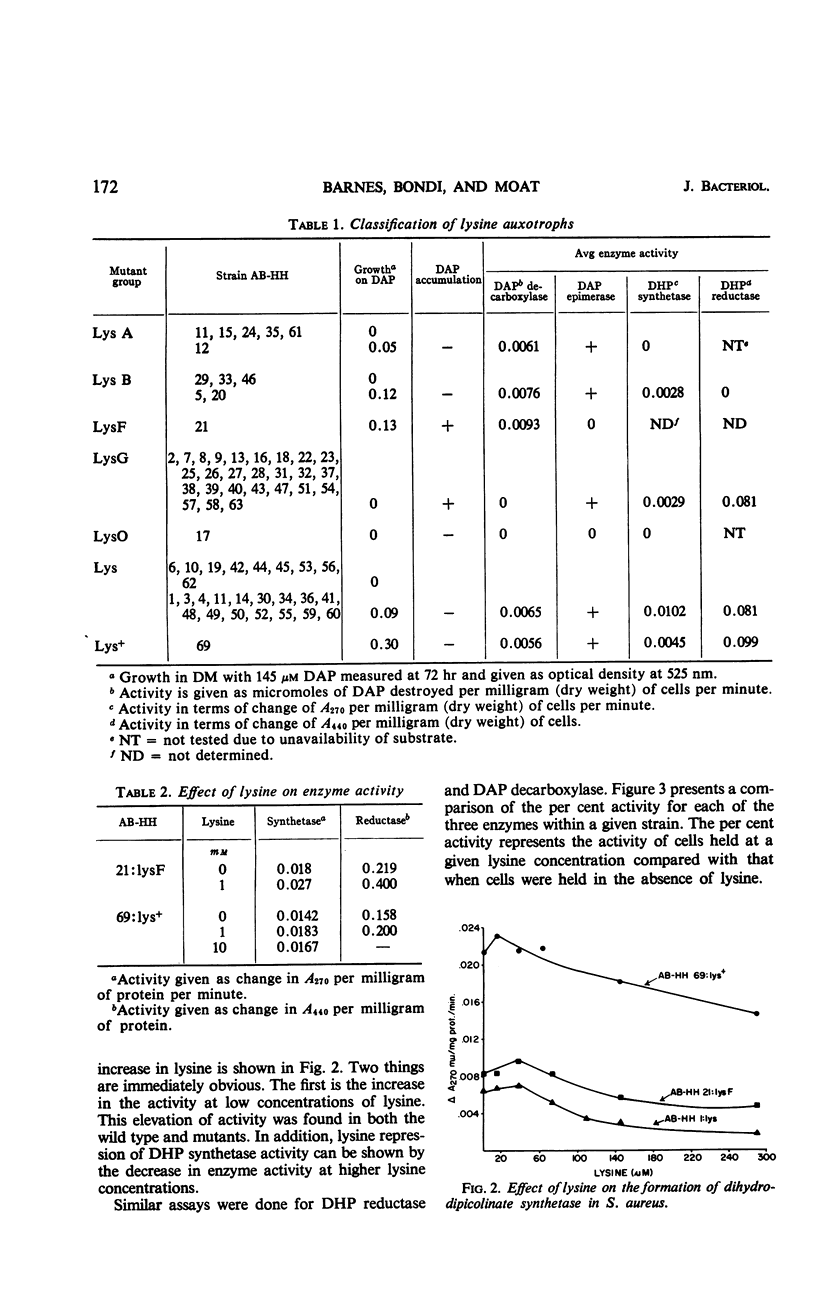Abstract
Lysine biosynthesis in Staphylococcus aureus has been studied by use of a series of lysine auxotrophs. The strains were isolated after chemical mutagenesis. The majority of these mutant strains were classified according to the enzymatic step found to be deficient. Specific enzyme assays as well as nutritional tests were used to group the organisms. The enzymes included were dihydrodipicolinate synthetase, dihydrodipicolinate reductase, diaminopimelate epimerase, and diaminopimelate decarboxylase. The accumulation of diaminopimelate in certain mutants and the demonstration of dihydrodipicolinate synthetase and reductase provide the first detailed evidence that S. aureus utilizes the diaminopimelate pathway for lysine biosynthesis. A cell-free system was used to study the regulation of these enzymes with the exception of diaminopimelate epimerase. Lysine repressed all of the enzymes tested. The repression appeared to be coordinate in nature. The data presented provide suggestive evidence that the lysine biosynthetic region in S. aureus constitutes an operon.
Full text
PDF





Selected References
These references are in PubMed. This may not be the complete list of references from this article.
- ANTIA M., HOARE D. S., WORK E. The stereoisomers of alpha epsilon-diaminopimelic acid. III. Properties and distribution of diaminopimelic acid racemase, an enzyme causing interconversion of the LL and meso isomers. Biochem J. 1957 Mar;65(3):448–459. doi: 10.1042/bj0650448. [DOI] [PMC free article] [PubMed] [Google Scholar]
- BLACK S., WRIGHT N. G. Aspartic beta-semialdehyde dehydrogenase and aspartic beta-semialdehyde. J Biol Chem. 1955 Mar;213(1):39–50. [PubMed] [Google Scholar]
- BONDI A., KORNBLUM J., DE ST PHALLE M. The amino acid requirements of penicillin resistant and penicillin sensitive strains of Micrococcus pyogenes. J Bacteriol. 1954 Nov;68(5):617–621. doi: 10.1128/jb.68.5.617-621.1954. [DOI] [PMC free article] [PubMed] [Google Scholar]
- CUMMINS C. S., HARRIS H. The chemical composition of the cell wall in some gram-positive bacteria and its possible value as a taxonomic character. J Gen Microbiol. 1956 Jul;14(3):583–600. doi: 10.1099/00221287-14-3-583. [DOI] [PubMed] [Google Scholar]
- Farkas W., Gilvarg C. The reduction step in diaminopimelic acid biosynthesis. J Biol Chem. 1965 Dec;240(12):4717–4722. [PubMed] [Google Scholar]
- GILVARG C. N-Succinyl-L-diaminopimelic acid. J Biol Chem. 1959 Nov;234:2955–2959. [PubMed] [Google Scholar]
- Gilboe D. P., Friede J. D., Henderson L. M. Effect of hydroxylysine on the biosynthesis of lysine in Streptococcus faecalis. J Bacteriol. 1968 Mar;95(3):856–863. doi: 10.1128/jb.95.3.856-863.1968. [DOI] [PMC free article] [PubMed] [Google Scholar]
- KINDLER S. H., GILVARG C. N-Succinyl-L-2,6-diaminopimelic acid deacylase. J Biol Chem. 1960 Dec;235:3532–3535. [PubMed] [Google Scholar]
- Knox K. W., Vesk M., Work E. Relation between excreted lipopolysaccharide complexes and surface structures of a lysine-limited culture of Escherichia coli. J Bacteriol. 1966 Oct;92(4):1206–1217. doi: 10.1128/jb.92.4.1206-1217.1966. [DOI] [PMC free article] [PubMed] [Google Scholar]
- LEDERBERG J., LEDERBERG E. M. Replica plating and indirect selection of bacterial mutants. J Bacteriol. 1952 Mar;63(3):399–406. doi: 10.1128/jb.63.3.399-406.1952. [DOI] [PMC free article] [PubMed] [Google Scholar]
- LOWRY O. H., ROSEBROUGH N. J., FARR A. L., RANDALL R. J. Protein measurement with the Folin phenol reagent. J Biol Chem. 1951 Nov;193(1):265–275. [PubMed] [Google Scholar]
- PETERKOFSKY B., GILVARG C. N-Succinyl-L-diaminopimelic-glutamic transaminase. J Biol Chem. 1961 May;236:1432–1438. [PubMed] [Google Scholar]
- RONEN A. BACK MUTATION OF LEUCINE-REQUIRING AUXOTROPHS OF SALMONELLA TYPHIMURIUM INDUCED BY DIETHYLSULPHATE. J Gen Microbiol. 1964 Oct;37:49–58. doi: 10.1099/00221287-37-1-49. [DOI] [PubMed] [Google Scholar]
- STADTMAN E. R. Symptosium on multiple forms of enzymes and control mechanisms. II. Enzyme multiplicity and function in the regulation of divergent metabolic pathways. Bacteriol Rev. 1963 Jun;27:170–181. doi: 10.1128/br.27.2.170-181.1963. [DOI] [PMC free article] [PubMed] [Google Scholar]
- Shaw W. V., Brodsky R. F. Characterization of chloramphenicol acetyltransferase from chloramphenicol-resistant Staphylococcus aureus. J Bacteriol. 1968 Jan;95(1):28–36. doi: 10.1128/jb.95.1.28-36.1968. [DOI] [PMC free article] [PubMed] [Google Scholar]
- WORK E. Reaction of ninhydrin in acid solution with straight-chain amino acids containing two amino groups and its application to the estimation of alpha epsilon-diaminopimelic acid. Biochem J. 1957 Nov;67(3):416–423. doi: 10.1042/bj0670416. [DOI] [PMC free article] [PubMed] [Google Scholar]
- Yugari Y., Gilvarg C. The condensation step in diaminopimelate synthesis. J Biol Chem. 1965 Dec;240(12):4710–4716. [PubMed] [Google Scholar]


